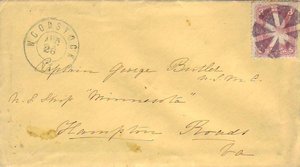MINNESOTA
USS MINNESOTA, a wooden steam frigate, was laid down in May 1854 by Washington Navy Yard; launched 1 December 1855; sponsored by Miss Susan L. Mann; and commissioned 21 May 1857, Capt. S. F. Dupont in command.
MINNESOTA, carrying William B. Reed, U.S. Minister to China, departed Norfolk 1 July 1857 for the Orient. During her service with the East India Squadron, she visited many of the principal ports of China and Japan before departing Hong Kong to bring Mr. Reed home with a newly negotiated Treaty of Commerce with China. Upon arrival in Boston 2 June 1859, MINNESOTA decommissioned at the Boston Navy Yard, 2 June 1859 and remained in ordinary until the outbreak of the Civil War.
MINNESOTA recommissioned 2 May 1861, Capt. G. J. Van Brunt in command, and became flagship of the Atlantic Blockading Squadron, commanded by Flag Officer Silas Stringham. She arrived Hampton Roads 13 May and the next day captured schooners Mary Willis, Delaware Farmer, and Emily Ann. MINNESOTA took bark Winfred on the 25th and bark Sally McGee 26 June. Schooner Sally Mears became her prize 1 July and bark Mary Warick struck her colors to the steam frigate on the 10th.
MINNESOTA led a joint Army‑Navy expedition against two important Confederate forts which had been erected at Hatteras Inlet, N.C. The squadron opened fire on Fort Clark on the morning of 28 August 1861 forcing the Confederate gunners to abandon the fort at noon. The following day, the fire of the squadron was concentrated on Fort Hatteras. The bombardment was so effective the Confederates were compelled to seek cover in bomb shelters and surrendered.
When Flag Officer Louis M. Goldsborough relieved Stringham in command of the North Atlantic Blockading Squadron 23 September, he selected MINNESOTA as his flag ship.
While blockading off Hampton Roads, 8 March 1862, MINNESOTA sighted three Confederate ships, Jamestown, Patrick Henry, and Virginia—the former Merrimack, rebuilt and protected by iron plates—rounding Sewell’s Point and heading toward Newport News. Minnesota slipped her cables and got underway to engage the southern warships. When about 11❄2 miles from Newport News, MINNESOTA grounded.
Meanwhile Virginia passed frigate Congress and rammed sloop‑of‑war Cumberland. Virginia then engaged Congress compelling her to surrender. Then Virginia, Jamestown, and Patrick Henry bombarded MINNESOTA killing and wounding several of her crew before the Union warship’s heavy guns drove them off. MINNESOTA also fired upon Virginia with her pivot gun. Toward twilight the southern iron‑clad withdrew toward Norfolk.
The recoil from her broadside guns forced MINNESOTA further upon the mud bank. All night tugs worked to haul her off, but to no avail. However, during the night Monitor arrived. Early the next morning Virginia reappeared. As the range closed, Monitor, steaming between MINNESOTA and the iron‑clad, fired gun after gun, and Virginia returned fire with whole broadsides, neither with much apparent effect. Virginia, finding she could not hurt Monitor, turned her attention to MINNESOTA, who answered with all guns. Virginia fired from her rifled bow gun a shell which passed through the chief engineer’s stateroom, through the engineers’ mess room, amidships, and burst in the boatswain’s room, exploding two charges of powder, starting a fire which was promptly extinguished.
At midday Virginia withdrew toward Norfolk and the Union Navy resumed its efforts to refloat MINNESOTA. Early the next morning steamer S. R. Spaulding and several tugs managed to refloat the frigate and she anchored opposite Fort Monroe for temporary repairs.
For the next few years she served as flagship of the North Atlantic Blockading Squadron. While anchored off Newport News 9 April 1864, MINNESOTA was attacked by Confederate torpedo boat Squib who exploded a torpedo charge alongside without causing damage and escaped.
On 24 and 25 December, MINNESOTA took part in amphibious operations at Fort Fisher which guarded Wilmington, N.C. During the landings she took a position about a mile from the fort and laid down a devastating barrage on the Confererate stronghold. However, Gen. B. F. Butler withdrew his troops nullifying the gains won by the joint Army‑Navy effort. Three weeks later the Union Navy returned Federal Troops, now commanded by the more vigorous General Terry, to Fort Fisher. A landing force of 240, men from MINNESOTA, covered by a barrage from their own ship, participated in the successful assault. This operation closed Wilmington, denying the Confederacy the use of this invaluable port.
Ordered to Portsmouth, N.H., MINNESOTA decommissioned 16 February 1865. She recommissioned 3 June 1867, and made a cruise with midshipmen to Europe. She was placed in ordinary at the New York Navy Yard, 13 January 1868. Recommissioned 12 June 1875, she remained at the New York Navy Yard as gunnery and training ship for naval apprentices. In October 1895, she was loaned to the Massachusetts Naval Militia, continuing that duty until August 1901 when she was sold to Thomas Butler & Co. of Boston. She eventually was burned at Eastport, Maine.
| Thumbnail Link To Cachet Close-Up Image | Thumbnail Link To Full Cover Front Image | Thumbnail Link To Postmark or Back Image | Primary Date Postmark Type Killer Bar Text --------- Cachet Category |
|---|
|
N/A |
 |
N/A |
c 1860's |
|
Incoming mail |
Letter to Captain George Butler, USMC.
If you have images to add to this page, then either contact the Curator or edit this page yourself and add them. See Editing Ship Cover Pages for detailed information on editing this page.
Copyright 2024 Naval Cover Museum